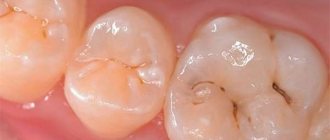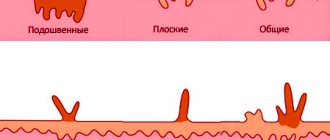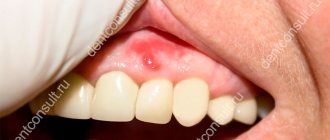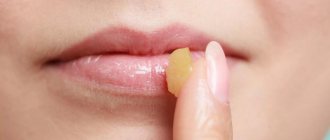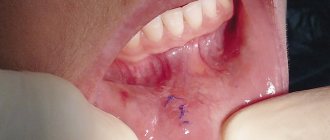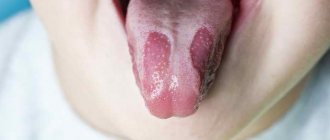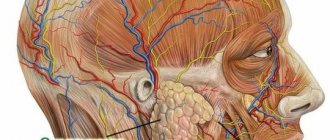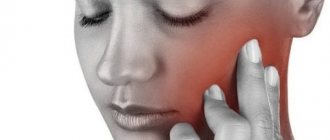Partial and complete absence of teeth - types of adentia and its consequences
The term “edentia” refers to a pathological condition in which a person has no teeth. In this case, there is partial and complete adentia, that is, when several or all teeth are missing, respectively. The problem can be either congenital or acquired, and various external factors can influence the development of such a pathology. What is it, why do adults and children encounter such a problem, what to do if there are not enough teeth in the mouth or no teeth at all - read about this and more further in this material.
Adentia - what is pathology?
The problem under consideration is characterized by the loss of individual elements of the jaw or the complete absence of teeth. Unfortunately, such a diagnosis is not uncommon in dentistry. Due to edentia, facial features are gradually deformed, diction is impaired, problems with the stomach and digestion appear, as a person loses the ability to chew food thoroughly.
Adentia - absence of teeth
In addition, the patient is faced with a serious aesthetic problem, especially if the “gaps” are located in the smile area. As a result, serious psychological complexes develop, which in general have an extremely detrimental effect on the quality of life. That is why, in the event of destruction and loss of even one or several teeth, it is important to restore the integrity of the row as soon as possible. If a child takes too long to develop baby teeth, you should urgently take him to a pediatric dentist. In order to be able to respond to the problem in a timely manner, it is important for parents to know the timing and pattern of cutting through time units.
What is edentia
Adentia is a type of pathology characterized by a lack of teeth of varying degrees of distribution. The disease is usually classified into subtypes, depending on:
- nature of appearance (congenital or acquired);
- degree of severity (full or partial).
To date, it has not been possible to collect irrefutable facts to explain the cause of the disease.
Explaining the reasons for the absence of permanent teeth, doctors are inclined to believe that it appears as a consequence of poorly healed baby teeth. Also, factors that increase the chances of this anomaly occurring include hereditary predisposition and metabolic disruptions, which prevents the proper formation of tooth buds. Often, patients have concomitant abnormalities in the form of impaired formation of nails or hair.
The absence of some teeth, for example, lateral incisors or wisdom teeth, is subject to a certain pattern. It has been statistically confirmed that a lack of second incisors is observed in 0.9% of cases, and the rudiments of the second premolars in the lower row in childhood are absent in 0.5%. This developmental anomaly is explained by a general decrease in the load when chewing on the jaw bone of modern humans, compared to our distant ancestors. During evolution, the size of the jaw bone changed, which caused a situation of a banal lack of space for the development of the rudiments of molars.
The influence of heredity is also great in the case of symmetrical incomplete edentia. There have been cases where teeth, even in the presence of rudiments, never erupted, remaining at the level of the alveolar bone, which is clearly visible on x-rays. As a result, such a tooth creates many problems, starting with the appearance of neuralgic pain and ending with deformation of the adjacent roots. It is important to note that in primary occlusion such a developmental anomaly is diagnosed extremely rarely. Regarding children, one should take into account the fact that some teeth tend to erupt later than the period that falls within the limits of physiological norms. The reason for this is the lack of space in the dentition.
True adentia should be distinguished from retention. Retention is a time delay in the development (growth) of permanent teeth. Causes of retention: metabolic disorders, heredity.
Most often, displacement of impacted teeth is observed. Impacted teeth often do erupt, and sometimes the waiting period can be as long as decades. You can speed up eruption with the help of orthopedic intervention. Consequences of retention: displacement of adjacent teeth, jaw deformation, and the addition of inflammatory processes. Therefore, we should not forget about the importance of control over this process.
What types of adentia are there - classification
To make an accurate diagnosis, experts in the field of dentistry and orthodontics are guided by a basic classification of edentulism. Thus, the various manifestations of pathology can be divided into 4 main types:
- primary complete - can appear on both milk and permanent teeth in children, characterized by the absence of their rudiments. Over time, the asymmetry of the face is disrupted, and the alveolar processes develop incorrectly. To diagnose the anomaly, it is necessary to undergo an X-ray examination. Typically, patients have a reduced size of the lower jaw. If we are talking about the pathology of permanent occlusion, then it means that after the loss of milk units, the permanent ones do not erupt,
- primary partial - the absence of part of the dairy or permanent elements of the series is assumed, and a similar situation occurs a little more often. The anomaly may concern symmetrically located units, for example, there are no antagonistic incisors, or teeth may be missing in a random order,
- secondary partial – diagnosed when temporary or adult teeth are lost due to various internal or external factors. As a result, the remaining elements are forced to take on the entire chewing load, which is why they begin to quickly wear out and collapse. All this provokes the development of dental diseases, as well as atrophy of bone tissue in the area of lost units,
- secondary complete – loss of all teeth, including on both jaws due to the development of pathology or natural aging of the body. The facial features, jaw, and upper lip gradually become noticeably closer to the tip of the nose, and the lips and cheeks recede. The person loses the ability to eat and speak normally. In this case, urgent complete restoration of the jaw system is required.
According to official data, the complete primary form is rare in dental practice, and partial adentia among children occurs in only less than one percent. The prevalence of partial tooth loss with age for various reasons reaches a critical level of 75%. Complete toothlessness is a problem that affects about 25% of people over 60 years of age1.
Classification
There are quite a few types of this pathology in dentistry. The first division of the disease is based on the causes and time of formation of the disease:
- primary adentia – often formed against the background of a genetic predisposition;
- secondary adentia – acts as acquired and in the vast majority of cases develops against the background of dental ailments.
Based on the number of missing dental units, the following are distinguished:
- partial adentia – there are several missing teeth. This flow option means the absence of no more than 10 units. The most commonly affected teeth are the upper lateral incisors, second premolars, and third molars. If a person is missing more than 10 teeth, then multiple adentia is diagnosed.
- completely edentulous.
Classification by localization of pathology:
- edentulous lower jaw;
- edentulous upper jaws.
In addition, a similar disease in a child or adult is also divided into:
- true – characterized by the absence of the rudiment of dental units;
- false – occurs when nearby crowns merge or when teething is delayed;
- symmetrical;
- asymmetrical.
Features of symptoms in the absence of teeth
The accompanying symptoms of the anomaly depend on its specific form. Next, we will consider in detail what symptoms are characteristic of congenital and acquired forms of pathology.
Primary form
Congenital adentia always involves certain deviations in skeletal development. An X-ray can reveal the absence of rudiments - visually this manifests itself in the form of a too flat palate, as well as an abnormally small size of the lower part of the face. The jaw is underdeveloped; in some cases, its bone tissue does not fuse with the cranial bone. Often, children's eyebrows and eyelashes do not grow, and their skin is very dry. There are also problems with nasal-oral breathing, impaired diction, and the inability to pronounce individual sounds.
With congenital adentia, the rudiments of permanent teeth are absent, and milk teeth may be partially present
If we are talking about a partial form of pathology, then there are large gaps between the teeth. Gradually, the present elements begin to shift towards the “voids”, which is why their growth is disrupted.
Secondary adentia
Experts include a noticeable displacement of the jaw closer to the nose, the formation of multiple wrinkles on the face, especially near the mouth, as well as sinking of the cheeks and lips, and bone protrusions forming here and there on the jaw itself as signs of the acquired full form. All this inevitably leads to impaired speech function, the inability to eat and chew food normally, which causes problems with the gastrointestinal tract. Bone tissue atrophy gradually develops.
With secondary adentia, the jaw moves closer to the nose
If there are still teeth in the mouth, they begin to rapidly decay under excessive chewing load, which is distributed incorrectly. The best solution to the problem is implantation - only by implanting titanium analogues of roots can the aesthetics of a smile and the functionality of the dentofacial apparatus be completely restored, as well as stopping bone tissue resorption. Neither a bridge nor a removable orthopedic structure will protect the jawbone from atrophy.
Possible causes of the problem
As for the primary form of the anomaly, it is extremely rare, and the reasons for its development are not fully understood. It is known that the formation of the rudiments of future teeth occurs at approximately 7-10 weeks of pregnancy, while the rudiments of permanent units are formed at the 17th week. It is likely that severe stress or exposure to powerful toxic substances during this period can lead to a collision with the problem in question.
Severe stress or exposure to powerful toxic substances in the womb can affect the formation of teeth
On a note! Such a deviation is usually accompanied by other disorders in the development of the child’s body. Often the patient experiences pathological changes in the structure of the skin and mucous membranes.
Now let's look at the potential prerequisites for secondary adentia. Among the most common causes are the following conditions and phenomena:
- advanced form of caries, pulpitis,
- late stages of periodontitis and periodontitis,
- severe damage to the element and the need to remove it,
- serious hormonal imbalances,
- severe infectious diseases,
- periostitis, abscess, phlegmon,
- venereal diseases,
- oncology.
This is only a part of the possible reasons, often leading to partial or even complete adentia. The patient may also encounter a similar problem due to the fault of the dentist, who made fatal mistakes during treatment. For example, a specialist could accidentally touch the root tip and introduce an infection there. In such a situation, urgent medical attention is required.
How is diagnostics carried out?
Different specialists may be involved in examining the patient. An approximate diagnostic scheme is as follows:
- First, the doctor collects anamnesis,
- then a thorough examination of the oral cavity is carried out with palpation of the gingival tissues,
- the patient is sent for radiography to obtain more detailed information about the clinical picture,
- If necessary, a panoramic photograph is taken - if we are talking about the lack of a large number of teeth.
For diagnosis, an x-ray examination is required.
The above described manipulations allow us to assess the condition of the oral cavity as a whole, identify possible tumors and signs of inflammatory processes. A thorough diagnosis makes it possible to prescribe the most appropriate treatment for each specific case.
Diagnosis of edentia
Dental pathology such as adentia, the treatment of which is necessary to normalize the basic vital functions of a person, requires a high-quality, complete diagnosis, during which it will be possible to establish the main cause of the pathology and develop a treatment plan.
The process of diagnosis and subsequent treatment involves consultation with specialists such as a periodontist, surgeon, orthopedist, implantologist and orthodontist.
The initial diagnosis is established based on the collection and thorough analysis of the patient’s complaints, as well as the clinical picture of the disease. The dentist also draws up a chronological picture of the disease, in which the main role is given to comparing the patient’s age and the number of teeth, as well as the nature of their absence.
Dentists can make an accurate diagnosis based on a spot X-ray examination of the oral cavity. If all teeth or a significant number of them are missing, then a panoramic x-ray is performed; a computed tomography scan of the TMJ and its x-ray can also be performed in combination.
Based on the results of an X-ray examination, the doctor can determine whether there is a pathology in the development of the tooth germ, the level of coverage of the root by the gum, the presence of tumors inside the jaw, and identify inflammatory processes.
In order to draw up a treatment plan, an impression and subsequent production of a model of the patient’s jaw will be required. Performed individually for each clinical case.
Features of adentia in childhood
As mentioned above, congenital absence of rudiments is a rather rare phenomenon. Among the possible causes of such an anomaly, experts highlight unfavorable conditions for the formation of the fetus even at the stage of intrauterine development. As a result, the entire jaw system develops incorrectly, which leads to distortion of facial features and further problems in the gastrointestinal tract.
But parents should not panic ahead of time, since the timing of the eruption of baby and permanent teeth may vary. Perhaps the child has only a delay in the formation of the jaw apparatus, but all the rudiments are in place. An X-ray examination will help determine the cause of late eruption.
“It happened to my daughter like that. When the teeth still didn’t appear after 6 months, I really panicked and took the child to a dentist I knew. Fortunately, the doctor is experienced, he felt the entire gum and said that the lower incisors are just about to approach, so there is nothing to worry about. As far as I know, the absence of rudiments is a huge rarity, so don’t worry ahead of time...”
Marinka, Smolensk, from correspondence on the woman.ru forum
Scheme for the eruption of children's teeth
In order not to worry in vain, parents need to familiarize themselves in advance with the established dates for the appearance of the first and adult teeth. If this process is delayed in a child, it is better to show him to a specialist.
Treatment of pathology - prosthetic options
The fundamental direction of treatment of adentia is prosthetics. So, for example, if a patient is missing one tooth or segment, a crown or bridge can be installed. If a significant number of elements of a row are missing, there is an option to install a removable denture with fastening on the remaining elements. However, the best solution to the problem will still be implantation - complete restoration of the element along with the root. Let's consider possible options for correcting the anomaly, based on its form:
- primary partial: first, the doctor needs to direct the growth of the rudiments present in the right direction (if, of course, this is possible). This is necessary so that the crowns appear in the right places. If you address this issue as early as possible, it is possible to avoid deformation of the jaw apparatus. After the last sevens appear, you can begin full-fledged treatment - prosthetics. In this case, a special removable denture is fixed, and as soon as the jaw stops growing, a permanent bridge structure is installed. In the future, it is best to install implants instead of the missing elements, and fix the crowns on them,
- primary complete: treatment usually begins at the age of 3 years. To replenish the rows, prosthetic structures with platinum are fixed. They require replacement every two years as the child's body is constantly growing and developing. When a person reaches a certain age, full implantation can be performed,
- secondary partial: if part of the teeth has been lost due to certain external or internal factors, you can resort to using a “bridge”, a removable or fixed prosthesis - depending on the situation. The best solution, of course, is fixed prosthetics on implants,
- secondary complete: the most common solution to the problem is complete fixed prosthetics on implants. Of course, there are complete removable dentures, but they will not be able to provide full functionality of the jaw system, and the bone tissue will continue to atrophy at a rapid rate. The best option would be a comprehensive restoration using one of the one-stage techniques with immediate fixation of the prosthetic device.
In childhood, a special removable denture is used for treatment.
Immediately after prosthetics, the patient may encounter some complications, for example, denture stomatitis or an allergy to the materials from which the structure is made. If such side effects develop, you should immediately consult a doctor.
Stock
-13%
Removable overdenture on 4 implants RUB 150,000.
130,000 rub.
get -16 %
Premium implantation Nobel and zirconium dioxide crown 125,000 rub.
105,000 rub.
get -6 %
BASAL COMPLEX - Restoration of teeth on 1 jaw in 3 days 265,000 rub.
250,000 rub.
get -16 %
Premium implantation Nobel and zirconium dioxide crown 125,000 rub.
105,000 rub. get
What could be the consequences?
Edentia is a serious problem, and if you do not worry about restoring rows in time, you can face very unpleasant consequences. Among the possible complications, it is worth highlighting the following problems:
- speech defects – a person loses the ability to clearly pronounce individual sounds, there is a violation of diction,
- difficulties with biting and chewing food - with partial absence of teeth, the remaining elements take on the entire load, as a result of which they quickly deteriorate and collapse. As a result, after some time the person will be able to eat only liquid food,
- problems with the functioning of the gastrointestinal tract are a consequence of poor-quality chewing of food and the penetration of pathogenic bacteria from carious cavities into the body,
- disturbances in the functioning of the mandibular joint, which can lead to the development of inflammatory processes,
- serious psychological discomfort will entail the formation of stable complexes, which will have a detrimental effect on the quality of life in general.
Without treatment, this problem can cause physical and psychological discomfort
. The longer you delay treatment, the more the bone tissue will atrophy, which will significantly complicate implantation in the future. By the way, removable prosthetics will also not be able to solve this problem, and resorption of the jaw bone will continue to develop under the prosthesis.
Preventive actions
Tooth loss can be avoided if you organize proper oral care and monitor the health of your body. Dental experts offer the following recommendations in this regard:
- You need to brush your teeth at least twice every day,
- after eating, you should use a special thread to remove food debris, and also rinse your mouth with plain water or an antiseptic,
- You need to visit the dentist every six months - this will allow you to detect the problem in time and prevent the loss of elements of the jaw system,
- if any suspicious processes or phenomena are detected in the oral cavity, you need to see a specialist as soon as possible,
- If one or more units are lost, they should be restored as soon as possible.
It is also possible to prevent primary adentia in a child, and for this, the expectant mother needs to create the most favorable conditions for the formation of the fetus. Under no circumstances should you consume hazardous foods or alcohol. A woman needs to take care of her body, because she is responsible for both. If your baby does not have milk or permanent teeth for a long time, be sure to show him to the doctor.
Patient video review
- According to WHO.
Treatment
To eliminate the disease, orthopedic treatment methods are used. In case of partial edentia, before starting the main therapy the patient must undergo:
- professional cleaning of the oral cavity;
- complete elimination of dental problems;
- a procedure that eliminates tooth sensitivity;
- surgical excision of roots and teeth that cannot be saved.
Prosthetics for complete edentia or partial absence of dental units is performed by establishing:
- fixed structures
- removable dentures, which can be plate or clasp;
- dental implants.
Types of dental implants for edentulous patients
Primary adentia in children can begin to be treated from the moment the patient turns 4 years old. In such situations, orthopedic therapy is based on the production of complete removable dentures. It is worth noting that they need to be replaced every two years. Prosthetics through the use of partially removable dentures is allowed for congenital partial edentia.
In any case, treatment tactics are selected by a specialist individually for each patient, taking into account the anatomical, physiological and hygienic features of the human dental system.

